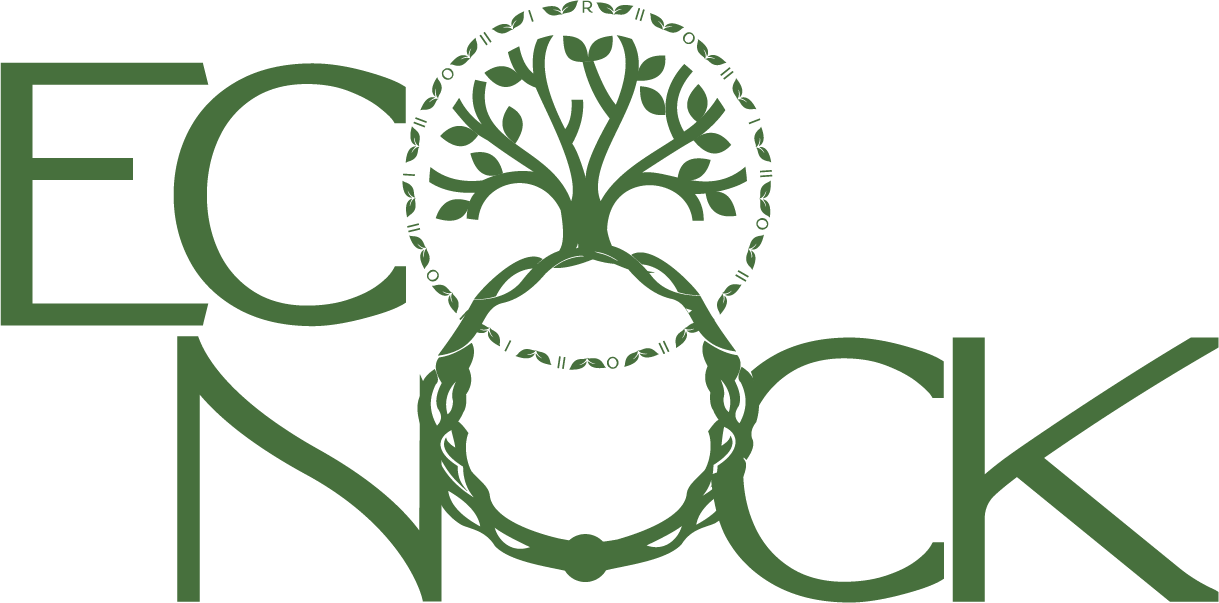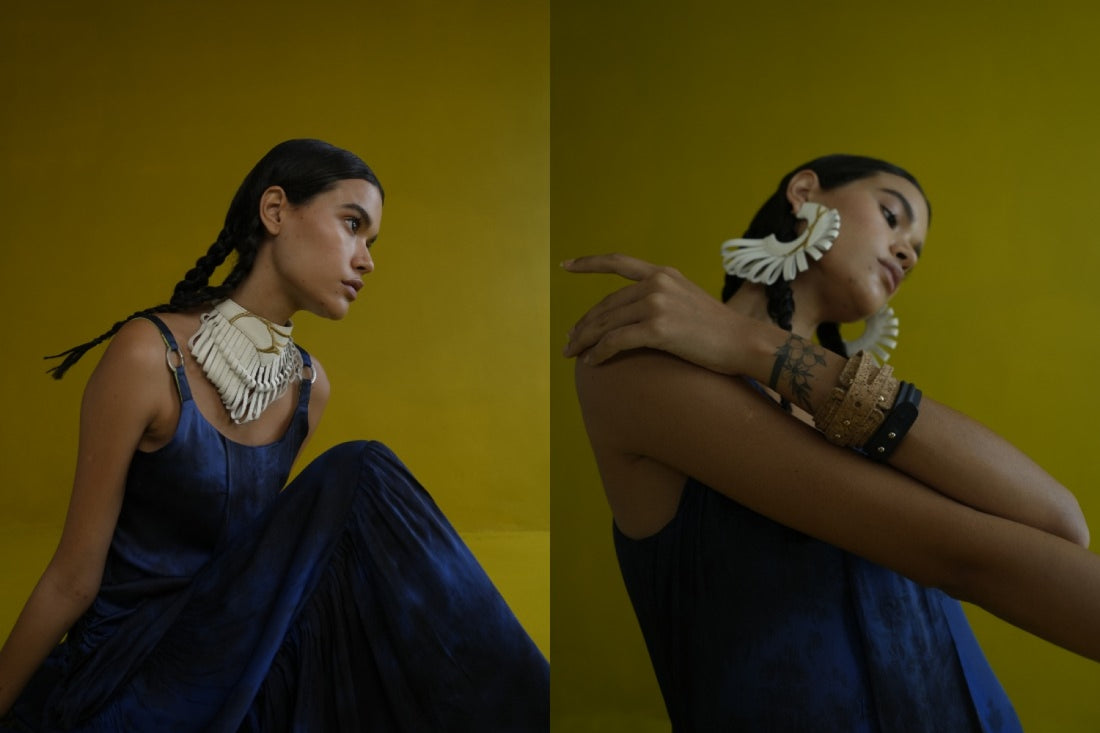For Ribhav Kapur, founder of the label Econock, it was during his tenure with an international brand when he embarked on a project that required him to work with limited resources. This led to a remarkable realisation — the potential of transforming waste into luxury. Inspired by this breakthrough, Ribhav pursued a Master's in Leadership in Sustainability in Sweden and established Econock to create luxurious upcycled accessories.
Creative head Gouri Rawal’s passion for unconventional accessory design, also resonated with Ribhav's vision. Together, they brainstormed a design language that promotes circularity and the transformative power of working with waste. He tells me, “Gouri envisioned designs that were not only well-crafted but impactful enough to showcase the potential of working with byproducts. The joint efforts led to a brand that not only offers sustainable fashion options but also contributes to waste reduction. Econock's accessories are meticulously crafted from upcycled materials such as discarded leather, old fabrics, and thread waste. Econock accessories are made from a variety of upcycled materials, including discarded leather, old fabrics, and thread waste.”
We’re in conversation with the duo who let us in on their process and more.
What were some of your initial thoughts for Econock?
Econock was founded with the primary goal of addressing the issue of waste in the industry. One of the main issues that Econock aimed to tackle was the prevalent practice of creating products in the name of sustainability without actually addressing the root cause of the problem. Many companies were simply patching up waste and selling it as a sustainable product, which did not contribute to the overall sustainability of the industry in the long run.
We aimed to change this by creating thoughtfully curated products that not only promoted sustainability but also stayed relevant and functional for a longer period of time. Our approach is to bridge the design gap when working with waste. We aim to show the potential of creating fashion-forward pieces out of industrial byproducts that were both functional and utilitarian. The focus of the brand is to promote the idea of circularity beneficially. We want to create a model where waste is not just seen as a problem but also as an opportunity to create something new and valuable. The circular economy approach that Econock adopted aims to keep resources in use for as long as possible, reducing waste and creating a more sustainable future for the industry.

What does the work in progress look like?
The work-in-progress days at Econock are a flurry of creativity and innovation as we strive to tackle waste head-on. Each day begins with our teams scouring various markets and resources to identify abundant sources of waste that can be upcycled. These materials then undergo a thorough process of sanitisation and assortment based on size, use, and quality. Larger panels are selected for bags, while even the smallest scraps are ingeniously repurposed as surface embellishments.
Our dedicated design team tirelessly conducts research, analysing colour trends and staying abreast of global happenings to curate a compelling design story. As a brand that identifies as "global warming ready," many of our silhouettes draw inspiration from utilitarian armours, blending functionality and style seamlessly. One pivotal day in our creative process is mood board day, hosted by Gouri. The entire team comes together, dividing and conquering to add intricate details that contribute to the overall collection's mood. This collaborative process resembles being in an art gallery, with team members offering a wide range of perspectives. Even our skilled craftsmen and kaarigars are involved, providing their insights and emotional connection to the stories being told.
Sampling our techniques to effectively utilise acquired waste follows soon after. Ribhav and our in-house team of craftsmen gather to brainstorm various techniques and meticulously sample swatches, ensuring their compatibility with our collection. And then comes the thrilling stage of prototyping concepts, which often involves friendly disagreements and debates between Ribhav and Gouri. The dynamic interplay adds an element of excitement and drama to our designs, resulting in captivating and unique creations. Finally, after an extensive creative journey, we proudly unveil our design curations, a testament to our dedication to sustainability and waste reduction. With each collection, we strive to push boundaries, redefine fashion, and inspire change within the industry.

What was the inspiration for the new collection?
The inspiration behind our collection stems from the concept of a Sophisticated Survivor, bridging the gap between the 1920s and the 2020s. The tumultuous year of 2020 brought widespread media coverage of the COVID-19 pandemic, resulting in a surge of essential protective gear that resembled armour. We envisioned a parallel silhouette in the anticipated glamour and hedonism of the Roaring 20s, realising that it could influence a humble yet powerful style for life after lockdown.
Our series is motivated by the growing expectation and demand for products, experiences, and systems that are smarter, simpler, and more sustainable. We recognise the need for the fashion industry and individuals to explore ways to build a more equitable world. The collection champions democratic and inclusive designs that work harder, last longer, and have versatile applications. We urge creators to consider not only how a product will be used in the present, but also how it will endure in the future. One of our focal points is shedding light on innovative techniques of upcycling that find a natural home in our collection. We embrace simple, architectural forms that either contour the body or emphasise functional details as shown in our monochromatic range Noir Et Blanc. Whereas our second story, Gold Riddance, is a pun on the good riddance of industrial byproducts which showcase confident and clear streams of gold tones, utilised either as all-over hues or as accentuations, conveying a sense of purpose and significance. Craftsmanship also holds relevance but is viewed through a technological filter that places equal value on the iterative work of our design process and the meticulous skill of handmade items as a showcase in our third all-upcycled leather range called the High-Braid.
Finally, what's coming up next?
Econock is constantly pushing the boundaries of sustainable fashion, and our upcoming ventures reflect our commitment to creative solutions. One exciting development is the extraordinary application of Kintsugi, a Japanese art form of mending broken pottery with gold, to the realm of waste. We have found a new way to mend discarded materials and transform them into a resort wear set of utilitarian accessories. This innovative approach allows us to give new life to waste while embracing the beauty of imperfection.
In addition to our foray into accessories, we are expanding our product range to include a new line of jewellery crafted from leather and metal. Recognising that waste extends beyond bags, we aim to utilise various materials to curb the excess waste generated by the fashion industry. By exploring alternative uses for discarded materials, we can create unique pieces that promote sustainability and style.
Furthermore, our dedication to finding innovative solutions leads us to explore unexplored avenues. We have developed a new fabric made from waste threads, a minute yet abundant byproduct of the fashion industry that often goes unnoticed. This fabric not only has broader applications beyond fashion, but also addresses the issue of thread waste. With this development, we strive to leave no thread behind, ensuring that even the smallest remnants find purpose and contribute to a circular economy.

